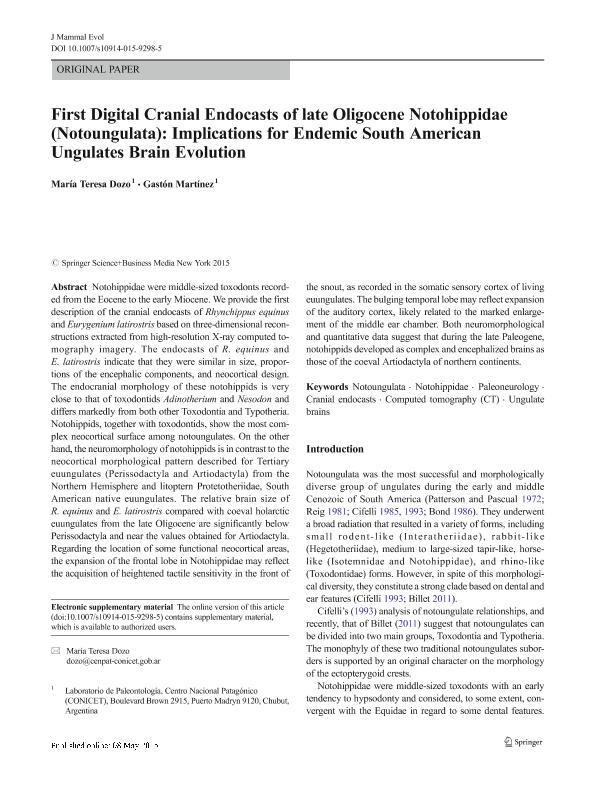Mostrar el registro sencillo del ítem
dc.contributor.author
Dozo, Maria Teresa

dc.contributor.author
Martínez, Gastón

dc.date.available
2017-07-21T20:17:06Z
dc.date.issued
2015-05-08
dc.identifier.citation
Dozo, Maria Teresa; Martínez, Gastón; First digital cranial endocasts of late oligocene notohippidae (Notoungulata): implications for endemic south american ungulates brain evolution; Springer; Journal of Mammalian Evolution; 23; 1; 8-5-2015; 1-16
dc.identifier.issn
1064-7554
dc.identifier.uri
http://hdl.handle.net/11336/21131
dc.description.abstract
Notohippidae were middle-sized toxodonts recorded from the Eocene to the early Miocene. We provide the first description of the cranial endocasts of Rhynchippus equinus and Eurygenium latirostris based on three-dimensional reconstructions extracted from high-resolution X-ray computed tomography imagery. The endocasts of R. equinus and E. latirostris indicate that they were similar in size, proportions of the encephalic components, and neocortical design. The endocranial morphology of these notohippids is very close to that of toxodontids Adinotherium and Nesodon and differs markedly from both other Toxodontia and Typotheria. Notohippids, together with toxodontids, show the most complex neocortical surface among notoungulates. On the other hand, the neuromorphology of notohippids is in contrast to the neocortical morphological pattern described for Tertiary euungulates (Perissodactyla and Artiodactyla) from the Northern Hemisphere and litoptern Protetotheriidae, South American native euungulates. The relative brain size of R. equinus and E. latirostris compared with coeval holarctic euungulates from the late Oligocene are significantly below Perissodactyla and near the values obtained for Artiodactyla. Regarding the location of some functional neocortical areas, the expansion of the frontal lobe in Notohippidae may reflect the acquisition of heightened tactile sensitivity in the front of the snout, as recorded in the somatic sensory cortex of living euungulates. The bulging temporal lobe may reflect expansion of the auditory cortex, likely related to the marked enlargement of the middle ear chamber. Both neuromorphological and quantitative data suggest that during the late Paleogene, notohippids developed as complex and encephalized brains as those of the coeval Artiodactyla of northern continents.
dc.format
application/pdf
dc.language.iso
eng
dc.publisher
Springer

dc.rights
info:eu-repo/semantics/openAccess
dc.rights.uri
https://creativecommons.org/licenses/by-nc-sa/2.5/ar/
dc.subject
Notoungulata
dc.subject
Notohippidae
dc.subject
Paleoneurology
dc.subject
Cranial Endocasts
dc.subject
Computed Tomography (Ct)
dc.subject
Ungulate Brains
dc.subject.classification
Paleontología

dc.subject.classification
Ciencias de la Tierra y relacionadas con el Medio Ambiente

dc.subject.classification
CIENCIAS NATURALES Y EXACTAS

dc.title
First digital cranial endocasts of late oligocene notohippidae (Notoungulata): implications for endemic south american ungulates brain evolution
dc.type
info:eu-repo/semantics/article
dc.type
info:ar-repo/semantics/artículo
dc.type
info:eu-repo/semantics/publishedVersion
dc.date.updated
2017-07-20T14:21:26Z
dc.identifier.eissn
1573-7055
dc.journal.volume
23
dc.journal.number
1
dc.journal.pagination
1-16
dc.journal.pais
Alemania

dc.journal.ciudad
Berlín
dc.description.fil
Fil: Dozo, Maria Teresa. Consejo Nacional de Investigaciones Científicas y Técnicas. Centro Nacional Patagónico; Argentina
dc.description.fil
Fil: Martínez, Gastón. Consejo Nacional de Investigaciones Científicas y Técnicas. Centro Nacional Patagónico; Argentina
dc.journal.title
Journal of Mammalian Evolution

dc.relation.alternativeid
info:eu-repo/semantics/altIdentifier/doi/http://dx.doi.org/10.1007/s10914-015-9298-5
dc.relation.alternativeid
info:eu-repo/semantics/altIdentifier/url/https://link.springer.com/article/10.1007%2Fs10914-015-9298-5
Archivos asociados
